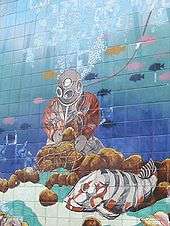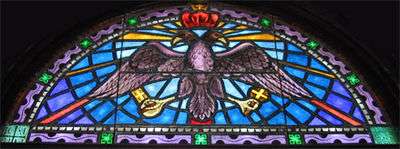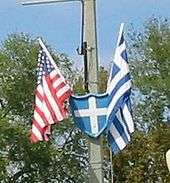Tarpon Springs, Florida
| Tarpon Springs, Florida | |
|---|---|
| City | |
|
Tarpon Springs waterfront | |
| Motto: Where culture and fun collide | |
 Location in Pinellas County and the state of Florida | |
 Tarpon Springs, Florida Location in the United States | |
| Coordinates: 28°9′N 82°45′W / 28.150°N 82.750°WCoordinates: 28°9′N 82°45′W / 28.150°N 82.750°W | |
| Country | United States |
| State | Florida |
| County | Pinellas |
| Incorporated | 1887[1] |
| Area | |
| • Total | 16.8 sq mi (43.8 km2) |
| • Land | 9.1 sq mi (23.7 km2) |
| • Water | 7.7 sq mi (20.1 km2) |
| Elevation | 23 ft (7 m) |
| Population (2010) | |
| • Total | 23,484 |
| • Density | 1,400/sq mi (540/km2) |
| Time zone | Eastern (EST) (UTC-5) |
| • Summer (DST) | EDT (UTC-4) |
| ZIP codes | 34688-34689 |
| Area code(s) | 727 |
| FIPS code | 12-71150[2] |
| GNIS feature ID | 0292048[3] |
| Website |
www |
Tarpon Springs is a city in Pinellas County, Florida, United States. The population was 23,484 at the 2010 census.[4] Tarpon Springs has the highest percentage of Greek Americans of any city in the US.[5] Downtown Tarpon has long been a focal point and is currently undergoing beautification.[6]
Geography
According to the United States Census Bureau, the city of Tarpon Springs has a total area of 16.9 square miles (44 km2). 9.1 square miles (24 km2) of it is land and 7.7 square miles (20 km2) of it (45.83%) is water.
Climate
| Tarpon Springs | ||||||||||||||||||||||||||||||||||||||||||||||||||||||||||||
|---|---|---|---|---|---|---|---|---|---|---|---|---|---|---|---|---|---|---|---|---|---|---|---|---|---|---|---|---|---|---|---|---|---|---|---|---|---|---|---|---|---|---|---|---|---|---|---|---|---|---|---|---|---|---|---|---|---|---|---|---|
| Climate chart (explanation) | ||||||||||||||||||||||||||||||||||||||||||||||||||||||||||||
| ||||||||||||||||||||||||||||||||||||||||||||||||||||||||||||
| ||||||||||||||||||||||||||||||||||||||||||||||||||||||||||||
Tarpon Springs' climate borders on humid subtropical and tropical savanna, with warm temperatures year-round, although winters nights are cool. Annual precipitation is around 50 inches (1,300 mm). Winters are warm, with daytime highs of 72 °F (22 °C) to 80 °F (27 °C), and nightly lows of 45 °F (7 °C) to 60 °F (16 °C). Freezing temperatures (32 °F (0 °C) or lower) occur on average 5-6 nights annually, while snowfall is extremely rare; there was accumulation in 1977 and 1989, while the years 1899, 1954, 1958, 1973, 2001, 2006, 2010, and 2014 either saw light snow mixed with rain, or flurries. The record low temperature of 19 °F (−7 °C) was observed on four different dates: December 1, 1962, December 13, 1962, December 14, 1962, and January 13, 1985. Summers are hot and very humid, causing frequent afternoon thunderstorms that can occasionally produce hail, and, even tornadoes or waterspouts off the Gulf of Mexico. Daytime temperatures usually range from 88 °F (31 °C) to 95 °F (35 °C), with temperatures over 100 °F (38 °C) very rare. The record high temperature of 102 °F (39 °C) was observed on July 10, 1997. Spring and fall are generally warm.
| Climate data for Tarpon Springs, FL | |||||||||||||
|---|---|---|---|---|---|---|---|---|---|---|---|---|---|
| Month | Jan | Feb | Mar | Apr | May | Jun | Jul | Aug | Sep | Oct | Nov | Dec | Year |
| Record high °F (°C) | 89 (32) |
89 (32) |
92 (33) |
92 (33) |
97 (36) |
100 (38) |
102 (39) |
99 (37) |
97 (36) |
94 (34) |
93 (34) |
88 (31) |
102 (39) |
| Average high °F (°C) | 72 (22) |
73 (23) |
77 (25) |
81 (27) |
87 (31) |
90 (32) |
91 (33) |
92 (33) |
90 (32) |
85 (29) |
79 (26) |
74 (23) |
83 (28) |
| Average low °F (°C) | 50 (10) |
52 (11) |
56 (13) |
61 (16) |
67 (19) |
72 (22) |
74 (23) |
73 (23) |
72 (22) |
65 (18) |
58 (14) |
52 (11) |
63 (17) |
| Record low °F (°C) | 19 (−7) |
23 (−5) |
31 (−1) |
37 (3) |
45 (7) |
51 (11) |
63 (17) |
64 (18) |
55 (13) |
42 (6) |
28 (−2) |
19 (−7) |
19 (−7) |
| Average precipitation inches (mm) | 3.17 (80.5) |
3.14 (79.8) |
3.85 (97.8) |
1.96 (49.8) |
3.02 (76.7) |
5.78 (146.8) |
7.07 (179.6) |
8.47 (215.1) |
7.25 (184.1) |
3.36 (85.3) |
2.37 (60.2) |
2.98 (75.7) |
52.42 (1,331.4) |
| Source: http://www.intellicast.com/Local/History.aspx?location=USFL0484 | |||||||||||||
History
The region, with a series of bayous feeding into the Gulf of Mexico, was first settled by white and black farmers and fishermen around 1876. Some of the newly arrived visitors spotted tarpon jumping out of the waters and so named the location Tarpon Springs. In the 1880s, it was developed as a wintering spot for wealthy northerners. During the same decade, John Cheyney founded the first local sponge business. The industry continued to grow in the 1890s, and many blacks and whites from Key West and the Bahamas settled in Tarpon Springs to harvest and process sponges. A few Greek immigrants arrived in this city during the 1890s to work in the sponge industry.

In 1905, John Cocoris introduced the technique of sponge diving to Tarpon Springs and recruited divers and crew members from Greece. The first divers came from the Saronic Gulf islands of Aegina and Hydra, but they were soon outnumbered by those from the Dodecanese islands of Kalymnos, Symi and Halki. The sponge industry soon became one of the leading maritime industries in Florida and the most important business in Tarpon Springs, generating millions of dollars a year. The 1953 film Beneath the 12-Mile Reef, depicting the sponge industry, takes place and was filmed in Tarpon Springs.[7]
In 1947, a red tide algae bloom wiped out the sponge fields in the Gulf of Mexico, causing many of the sponge boats and divers to switch to fishing shrimping for their livelihood, while others left the business. Eventually, the sponges recovered, allowing for a smaller but consistent sponge industry today. In the 1980s, the sponge business experienced a boom due to a sponge disease that killed the Mediterranean sponges. Today there is still a small active sponge industry. Visitors can often view sponge fishermen working at the Sponge Docks on Dodecanese Boulevard. In addition, visitors can enjoy shops, restaurants, and museum exhibits that detail Tarpon Springs' Greek heritage.
In 2007 and 2008, the City of Tarpon Springs established Sister City relationships with Kalymnos, Halki, Symi, and Larnaca, Cyprus, honoring the close historical link with these Greek-speaking islands.
Historic sites


There are several locations in Tarpon Springs which have been listed on the National Register of Historic Places:
- Tarpon Springs Historic District
- Tarpon Springs Greektown Historic District
- Arcade Hotel
- Old Tarpon Springs City Hall
- Old Tarpon Springs High School
- Safford House
Many sites related to the sponge industry within the Greektown District have also been recognized. They include but are not limited to two packing houses:
And several boats:
- N. K. Symi (Sponge Diving Boat)
- St. Nicholas III (Sponge Diving Boat)
- St. Nicholas VI (Sponge Diving Boat)
- Anastasi Sponge Diving Boat
Tourist attractions
_01.jpg)
Dodecanese Avenue in the Greektown Historic District of Tarpon Springs is still thriving as both a traditional community and a tourist destination. The street winds its way from Pinellas Avenue west along the Anclote River. Along the way it passes the marina, the sponge boats docked along the Sponge Docks on the north side of the street and the Sponge Exchange on the south side of the street, west to the boats docked outside Pelican Point Seafood. Numerous restaurants serve traditional Greek cuisine and fresh seafood. There are also small shops that sell everything from natural sponges to imported goods. Along the working waterfront street, locals greet each other in Greek and stop to chat without regard to the traffic.
The nearby beaches, part of the Pinellas County parks, are popular for swimming, windsurfing, picnics, boating, and other water sports. People also come to the beaches to watch the beautiful sunsets over the Gulf of Mexico. Sandy barrier islands off shore shift position over time with the waves and storms. They are accessible by boat and are especially ideal for shell spotting and watching bottlenose dolphins at play. One permanent island, Anclote Key, is a State Park Preserve with a historic lighthouse, bird nesting colonies and pristine beaches.
The Tarpon Springs Heritage Museum in Craig Park offers an exhibition about the history and culture of the Greek Community. The Cultural Center at 101 W. Pinellas Avenue has a changing roster of exhibits of local interest. The Safford House Museum on Parkin Court is a historical house museum that tells the fascinating story of one of the city's early families. The Depot Museum on Tarpon Avenue provides an overview of Tarpon Springs history.
Epiphany celebration

Tarpon Springs is known for elaborate religious ceremonies hosted by the St. Nicholas Greek Orthodox Church, part of the Greek Orthodox Church, including the January 6 Epiphany, celebration that includes youths diving for a cross and the blessing of the waters and the boats. Since the first Greek immigrants depended on the sea and their boats for their livelihood, their attachment to a religious service centered on requesting divine protection for what used to be a highly risky job can be easily explained.
The celebration attracts Greek Americans from across the country, and the city's population is known to triple in size for that day. The Metropolitan of Atlanta usually presides over the blessings, sometimes joined by the Archbishop of America. The blessings conclude with the ceremonial throwing of a wooden cross into the city's Spring Bayou, and boys ages 16 to 18 dive in to retrieve it: whoever recovers the cross is said to be blessed for a full year.[8] Following the blessings, the celebration moves to the Sponge Docks where food and music are made part of the festivities.
On January 6, 2006, the 100th anniversary celebration of the Epiphany services in Tarpon Springs was the occasion for a visit[9] by Bartholomew I, the Patriarch of Constantinople, who is considered "first among equals" of all hierarchs of the Orthodox Church. He presided over the Epiphany services in one of the few visits to America by an Ecumenical Patriarch.
Demographics
| Historical population | |||
|---|---|---|---|
| Census | Pop. | %± | |
| 1890 | 327 | — | |
| 1900 | 541 | 65.4% | |
| 1910 | 2,212 | 308.9% | |
| 1920 | 2,105 | −4.8% | |
| 1930 | 3,414 | 62.2% | |
| 1940 | 3,402 | −0.4% | |
| 1950 | 4,323 | 27.1% | |
| 1960 | 6,768 | 56.6% | |
| 1970 | 7,118 | 5.2% | |
| 1980 | 13,251 | 86.2% | |
| 1990 | 17,906 | 35.1% | |
| 2000 | 21,003 | 17.3% | |
| 2010 | 23,484 | 11.8% | |
| Est. 2014 | 24,239 | [10] | 3.2% |

As of the census[2] of 2000, there were 21,003 people, 9,067 households, and 5,947 families residing in the city. The population density was 2,297.1 per square mile (887.2/km²). There were 10,759 housing units at an average density of 1,176.7 per square mile (454.5/km²). The racial makeup of the city was 90.07% White, 6.15% African American, 0.29% Native American, 1.04% Asian, 0.06% Pacific Islander, 0.81% from other races, and 1.57% from two or more races. Hispanic or Latino of any race were 4.33% of the population. 11.8% of the total population reported their ancestry as Greek, which is included in the 90.07% White statistic. 8.87% reported speaking Greek at home, while 3.46% speak Spanish, and 1.09% French .
There were 9,067 households out of which 22.8% had children under the age of 18 living with them, 52.2% were married couples living together, 10.0% had a female householder with no husband present, and 34.4% were non-families. 29.2% of all households were made up of individuals and 14.6% had someone living alone who was 65 years of age or older. The average household size was 2.27 and the average family size was 2.78.
In the city the population was spread out with 19.2% under the age of 18, 6.2% from 18 to 24, 23.9% from 25 to 44, 25.9% from 45 to 64, and 24.8% who were 65 years of age or older. The median age was 45 years. For every 100 females there were 91.8 males. For every 100 females age 18 and over, there were 89.1 males.
The median income for a household in the city was $38,251, and the median income for a family was $46,316. Males had a median income of $36,356 versus $25,252 for females. The per capita income for the city was $21,504. About 7.7% of families and 9.8% of the population were below the poverty line, including 16.1% of those under age 18 and 7.9% of those age 65 or over.
- Scenes of Tarpon Springs
-

Dodecanese Avenue
-

Sponge docks
-

-

Tarpon Springs Boy Scouts wearing fustanellas (1960)
Notable people
- Michael Bilirakis, former United States Representative (1983-2007)
- Gus Bilirakis, United States Representative (2007- )
- Chris Coghlan, outfielder for the Miami Marlins, Chicago Cubs and 2009 Rookie of the Year
- Dieselboy, electronic music artist
- Billy "The Kid" Emerson, preacher and former rock and roll pianist and songwriter
- Elaine Esposito, record holder of the longest coma
- Wayne Fontes, former NFL coach for the Detroit Lions
- Bertie Higgins, singer of "Key Largo"
- William W. Kingsbury, United States House of Representatives, Territorial Delegate from Minnesota Territory
- Themistocles Leftheris, 2006 Olympian (with Naomi Nari Nam) in pairs figure skating
- Ted Watts, cornerback of the Oakland/Los Angeles Raiders, New York Giants, and San Diego Chargers
- 2 Pistols, rapper
References in entertainment
Tarpon Springs is referenced by Cmdr. Tucker in Star Trek: Enterprise episode "The Crossing".
See also
References
- ↑ "History" Tarpon Springs Area Historical Society
- 1 2 "American FactFinder". United States Census Bureau. Retrieved 2008-01-31.
- ↑ "US Board on Geographic Names". United States Geological Survey. 2007-10-25. Retrieved 2008-01-31.
- ↑ "Profile of General Population and Housing Characteristics: 2010 Demographic Profile Data (DP-1): Tarpon Springs city, Florida". U.S. Census Bureau, American Factfinder. Retrieved May 8, 2012.
- ↑ Greek ancestry by city - ePodunk
- ↑
- ↑ Crowther, Bosley (December 17, 1953). "Beneath the 12 Mile Reef". The New York Times. Retrieved 2009-04-28.
- ↑ "First-timer grabs the Epiphany cross in Tarpon Springs". January 7, 2013.
Archbishop Demetrios, primate of the Greek Orthodox Archdiocese of America, blessed the waters, then dropped the coveted cross into Spring Bayou...Thousands gathered to watch the cross dive, the centerpiece of Tarpon's annual Jan. 6 Epiphany celebration, which is considered the largest in the western hemisphere. The event commemorates the baptism of Jesus in the River Jordan by John the Baptist. Bells tolled early Sunday to mark the beginning of Epiphany. At 8 a.m., local and national Greek Orthodox clergy led the orthos and divine liturgy at the overflowing St. Nicholas Greek Orthodox Cathedral downtown. The services concluded with blessings and prayers for the 47 Greek boys ages 16 to 18 who would contend for the cross...The boy who retrieves the cross is said to receive a year of blessings.
- ↑ "100th Epiphany celebration comes to close".
Patriarch Bartholomew venerates an icon of St. Nicholas Sunday before performing the Orthros and Patriarchal liturgy while visiting St. Nicholas Greek Orthodox Cathedral in Tarpon Springs. It was His All Holiness' last public event in Tarpon Springs, following the 100th Epiphany celebration
- ↑ "Annual Estimates of the Resident Population for Incorporated Places: April 1, 2010 to July 1, 2014". Retrieved June 4, 2015.
- ↑ "Census of Population and Housing". Census.gov. Retrieved June 4, 2015.
External links
| Wikimedia Commons has media related to Tarpon Springs, Florida. |
- City of Tarpon Springs official website
- History of Tarpon Springs
- Fred Howard Park
- Anclote Key Preserve State Park
- Tarpon Springs Sponge Docks, Tarpon Springs Merchant Association
| |||||||||||||||||||||||||
| |||||||||||||||||||||||||||||
|


